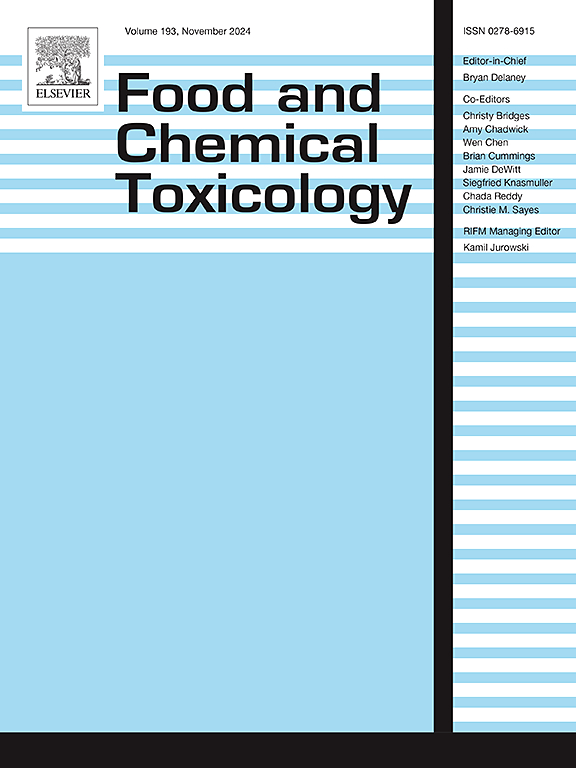Development of a TBXT-EGFP iPS cell model for screening the early developmental toxicity of typical environmental pollutants
IF 3.9
3区 医学
Q2 FOOD SCIENCE & TECHNOLOGY
引用次数: 0
Abstract
In our daily lives, we are inevitably exposed to a variety of environmental pollutants in numerous ways. Fortunately, recent years have witnessed significant advancements in the field of stem cell toxicology, which have provided new opportunities for research in environmental toxicology. Applying stem cell technology to environmental toxicology, overcomes some of the limitations of traditional screening methods and we can more accurately predict the toxicity of environmental pollutants. However, there are still several aspects of stem cell toxicology models that require improvement, such as increasing the throughput of detection and simplifying detection methods. Consequently, we developed an environmental pollutant toxicity detection model based on TBXT-EGFP iPS cells and screened the developmental toxicity of 38 typical environmental pollutants. Our results indicate that TBBPA-BDBPE, TBBPA-BHEE, DG, and AO2246 may interfere with the expression of TBXT, a critical marker gene for early human embryo development, implying that these environmental pollutants could lead to developmental abnormalities.

开发用于筛查典型环境污染物早期发育毒性的 TBXT-EGFP iPS 细胞模型。
在日常生活中,我们不可避免地以各种方式接触到各种环境污染物。幸运的是,近年来干细胞毒理学领域取得了重大进展,为环境毒理学研究提供了新的机遇。将干细胞技术应用于环境毒理学,克服了传统筛选方法的一些局限性,我们可以更准确地预测环境污染物的毒性。然而,干细胞毒理学模型仍有几个方面需要改进,如提高检测通量和简化检测方法。因此,我们开发了基于TBXT-EGFP iPS细胞的环境污染物毒性检测模型,并筛选了38种典型环境污染物的发育毒性。结果表明,TBBPA-BDBPE、TBBPA-BHEE、DG和AO2246可能会干扰人类早期胚胎发育的关键标记基因TBXT的表达,这意味着这些环境污染物可能会导致发育异常。
本文章由计算机程序翻译,如有差异,请以英文原文为准。
求助全文
约1分钟内获得全文
求助全文
来源期刊

Food and Chemical Toxicology
工程技术-毒理学
CiteScore
10.90
自引率
4.70%
发文量
651
审稿时长
31 days
期刊介绍:
Food and Chemical Toxicology (FCT), an internationally renowned journal, that publishes original research articles and reviews on toxic effects, in animals and humans, of natural or synthetic chemicals occurring in the human environment with particular emphasis on food, drugs, and chemicals, including agricultural and industrial safety, and consumer product safety. Areas such as safety evaluation of novel foods and ingredients, biotechnologically-derived products, and nanomaterials are included in the scope of the journal. FCT also encourages submission of papers on inter-relationships between nutrition and toxicology and on in vitro techniques, particularly those fostering the 3 Rs.
The principal aim of the journal is to publish high impact, scholarly work and to serve as a multidisciplinary forum for research in toxicology. Papers submitted will be judged on the basis of scientific originality and contribution to the field, quality and subject matter. Studies should address at least one of the following:
-Adverse physiological/biochemical, or pathological changes induced by specific defined substances
-New techniques for assessing potential toxicity, including molecular biology
-Mechanisms underlying toxic phenomena
-Toxicological examinations of specific chemicals or consumer products, both those showing adverse effects and those demonstrating safety, that meet current standards of scientific acceptability.
Authors must clearly and briefly identify what novel toxic effect (s) or toxic mechanism (s) of the chemical are being reported and what their significance is in the abstract. Furthermore, sufficient doses should be included in order to provide information on NOAEL/LOAEL values.
 求助内容:
求助内容: 应助结果提醒方式:
应助结果提醒方式:


